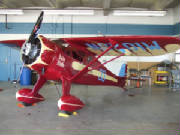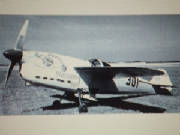|
|
 |
|
**An excellent website dedicated to the Monocoupe contains a number of
photos of Clayton Folkerts and his monocoupes** www.monocoupe.com
Clayton Folkerts

|
| Self-Taught Designer, Pilot, Engineer, Iowa Farmer |
Born on
November 9, 1897, on a Grundy County, Iowa farm, Clayton Folkerts was a self-taught designer, builder and pilot of early airplanes.
Experimenting with designs and materials
found on the family farm, he constructed five home-built aircraft from 1916 to 1926.
Clayton distinguished
himself in the airplane design field with the successful production of the Monocoupe. Working at Central States Aero in Davenport
for $35 a week, he taught himself to weld and solely built the Monocoupe prototype in 4 1/2 months.
The Monocoupe
was a side-by-side enclosed cockpit airplane designed for high performance using relatively little horsepower. It was put
into production in Bettendorf, Iowa and later in Moline, Illinois.
By the
end of 1928, 90% of all light planes and 10% of all licensed airplanes owned in the U.S. were Monocoupes. Even Col.
Charles Lindbergh ordered a Monocoupe equipped with brakes. By 1930, air races were dominated by Monocoupes. The Monocoupe 90, another Folkerts design, was a streamlined version of the original aircraft and
remained in production from 1930 to1950.
Clayton’s
later designs were centered on racing planes. His Speed King 2 won national titles from 1936 to1938. The “Jupiter”
won several air races in 1937. During WWII, Clayton was a project manager in Ohio for the development of trainers and assault
gliders.
In 1948,
Clayton returned to Iowa and farmed near Bristow. After retiring in 1950, he moved to an acreage near Iowa Falls and lived
there 14 years before he passed away in 1964.
|
 |
|

|
| 1928 Folkerts Henderson High Wing |

|
| Clayton Folkerts and His Mini Plane/High-Wing |
1928 Folkerts Henderson
High Wing
The Folkerts Henderson Highwing is an early, one-of-a-kind homebuilt
aircraft. Clayton Folkerts worked at Monocoupe and was experienced in aircraft design and construction. The Highwing is made
almost entirely of wood. The metal parts are the axle, tailskid, cabane struts, control surface hinges, wire trailing edges,
and hardware. The engine weight of 100 pounds is almost half the total weight of the plane. The aircraft carries a registration
number of 8902, but this registration predates the “N” number system. The Highwing was grounded by aviation law
changes in 1931 and ceased flying operations. It was restored for display by EAA Chapter 94, Rudd, IA in 1965.

|
| Monocoupe 70 |

|
| Monocoupe 113 |
Folkerts Monocoupes...
Don Luscombe wanted a more comfortable plane than his open cockpit “Jenny”.
His Monocoupe was engineered and built by Clayton Folkerts. Together, Don and Clayton launched a type of aircraft that dominated
the light plane scene for several years.
Production of the Monocoupe was sporadic until 1928 when the company
became associated with W. L. Velie, a former car manufacturer. Velie brought the Monocoupe a reliable source of small engines.
The 113 was manufactured by Mono Aircraft Corporation, which was a subsidiary of Allied Aviation Industries.
The Monocoupe was powered by a 65 hp Velie radial engine. The fuselage
framework was built of welded steel tubing, which was faired to shape with formers and fairing strips, and then was covered
with fabric. The cabin roof had a large skylight for vision overhead. The wings were built of solid spruce spars and spruce
and basswood ribs which were also fabric covered.
The Monocoupe
113 was reasonably stable and quite easy to fly. By 1929, approximately ten percent of all licensed US aircraft were Monocoupes.
The Monocoupe accumulated a good safety record and promoted longevity. Through the late 1930s it was not uncommon to see scores
of Monocoupes flying all over the countryside.
The exceptional performance and sharp maneuverability of the 113 drew
the Monocoupe to air races and other events where its pilot could show it off. During the 1929 air race season, many Monocoupes
were the headliners. The 113 was also used in the primary phases of flight instruction by flying schools.
EAA’s Monocoupe was the first of the famous Monocoupe line, which
was among the earliest cabin monoplanes. The airplane was meticulously restored and flown to the EAA Museum under its own
power. At that time, it was one of the last flyable 113s in existence. The Monocoupe 113 is an example of the type of airplane
that dominated the light plane scene for several years. In 1968, John Hatz loaned the Monocoupe to the EAA museum. In 1977
this airplane was put on permanent display there.
|
 |
|
|
 |
|
|
 |
|
|
|
|
Clayton Folkerts Racers...

|
| Folkerts Monocoupe 110 owned by famed race pilot Jonathan Livingston |

|
| Folkerts SK-2 Racer 1936 |

|
| Folkerts SK-3 Jupiter Racer 1937 |
|
|
|
 |

